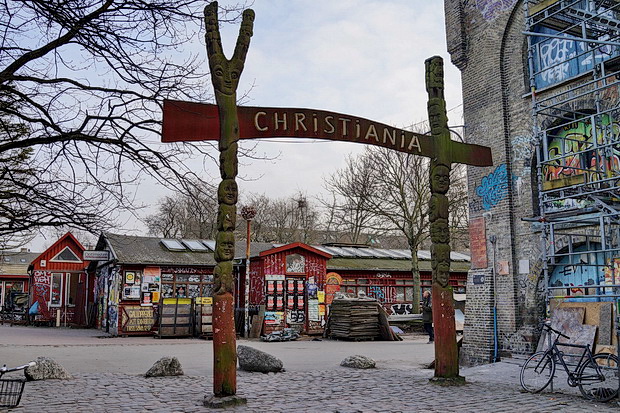
A self-proclaimed autonomous neighbourhood of about 850 residents, Christiania was created in 1971 when squatters and hippies took over the former Bådsmandsstræde barracks in Copenhagen, Denmark, which includes some of the finest surviving 17th century defence works in the world.
A short walk from the tourist-heaving old port of Copenhagen, Christiania (also known as Freetown Christiania) covers 34 hectares (84 acres) and is made up of a mix of workshops, art galleries, music venues, DIY houses and food outlets.
Described as a “society within a society,” Christiania’s inhabitants developed their own set of rules, independent of the Danish government, outlawing stealing, violence, guns, knives, bulletproof vests, hard drugs and the wearing of bikers’ colours.
Residents have found themselves in conflict with both the Danish state and outsiders over the decades, and there’s a long history of resistance, riots, violence, and even shootings and a grenade attack taking place in the past. [—]
One of the main attractions for some visitors is its main drag, known as Pusher Street, where hash and skunk weed continues to be sold openly, despite several crackdowns in the past.
I can’t say I enjoyed the ugly vibe in this part of Christiania at all: rows of dealers hustled at every corner, and their presence seemed at odds with the proclaimed principles of the neighbourhood.
In 1995, Christiania negotiated an arrangement with the Danish defense ministry (which still owns the land), which resulted in residents paying taxes and fees for water, electricity, trash disposal, etc.
Wikipedia updates the story:
In January 2006, the government proposed that Christiania would be turned into a mixed alternative community and residential area adding condominiums for 400 new residents.
Current residents, now paying DKK 1,450 (USD 250) per month, would be allowed to remain but need to begin paying normal rent for the facilities, albeit below market rent levels. Christiania has rejected this scenario, fearing the freetown would turn into a normal Copenhagen neighborhood. In particular, the concept of privately owned dwellings is claimed to be incompatible with Christiania’s collective ownership.
In September 2007, the representatives of Christiania and Copenhagen’s city council reached an agreement to cede control of Christiania to the city over the course of 10 years for the purposes of business development. Also, as of May 2009, the Eastern High Court upheld a 2004 Act of Parliament which reaffirmed the state’s legal claim to control of the base.
Here’s some more photos from the visit:
Seen from Christiania is this incredible 1752 baroque tower of Our Saviour’s Church, which houses an unusual musical instrument called a carillon:
The carillon in Our Saviour’s Church is famous. Both because the church is visited annually by more tourists than any other in Copenhagen, but also because the carillon was the first in Scandinavia in modern times. It was the organist P. S. Rung-Keller (1879-1966) who was inspired in the 1920s by the idea that the unique spire should be equipped with the world’s largest musical instrument: a carillon.
Copenhagen’s most recent carillon, in Vor Frue Church (the Church of Our Lady – the present cathedral of Copenhagen), had collapsed during the British bombardment of Copenhagen in September 1807. At the beginning of the 20th century, the only remaining carillon was in Frederiksborg Castle.
With donations from local citizens and from the Carlsberg Foundation, a 33-bell carillon was installed from 1928 to 1933 in the lantern of the spire; this was later enlarged to 48 bells. The six largest bells hang in the bell stock together with the swinging bells behind the shutters beneath the clock faces. The carillon keyboard, from which the carillonist plays the instrument, is in the gallery just above the clock faces while the remaining 42 bells hang in the open lantern above.
The carillon is now played on Saturdays at 4 pm by a number of Danish carillonists and in the summer, concerts are played at 6 pm by carillonists from abroad who visit Christianshavn to demonstrate their skills on these melodious bells. The carillon was restored in 1981 and is well-renowned for its finely tuned bells and its excellent mechanism from the bell foundry of Petit & Fritsen. [—]
Although it was a chilly March afternoon when we visited, the lack of any music at all around the site seemed strange.
One of the cafes.
There’s some beautiful buildings around the site.
Artwork.
‘Say No To Hard Drugs.’
There was a lot of smoking going on around this area.
Mosaic advertises the ‘Green Light District’ where you can buy marijuana and hashish.
Striking street art.
Metal sculpture.
Art gallery at the top of one of the historic buildings.
Years of posters outside Christiania are peeling off under their own weight.
Chat about Christiania on the forums


